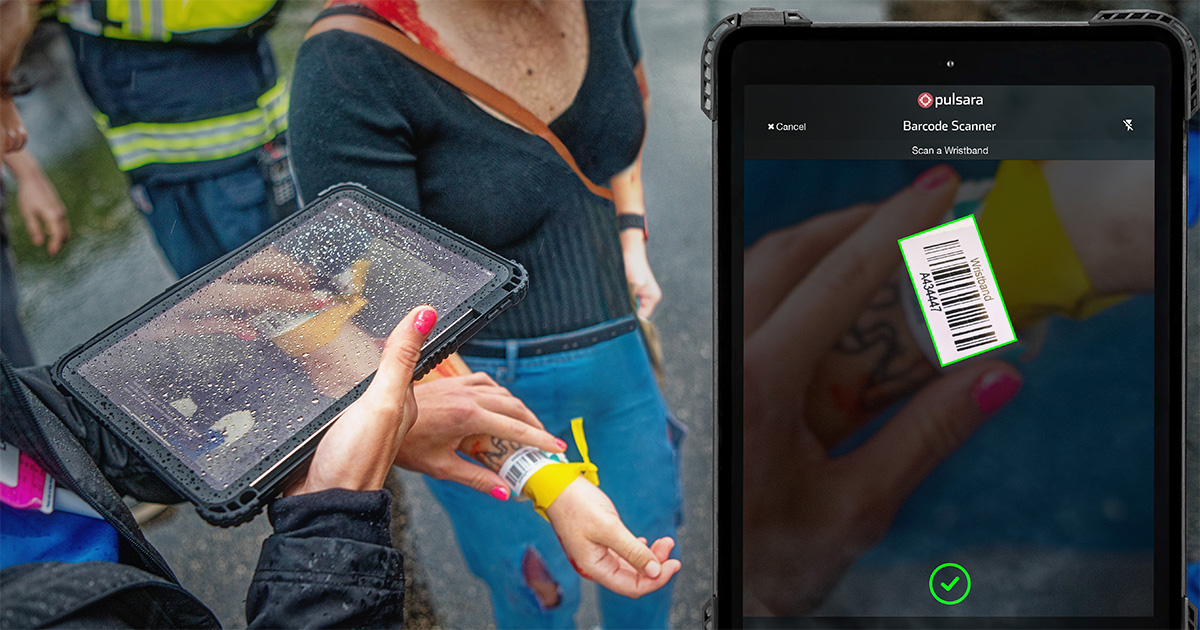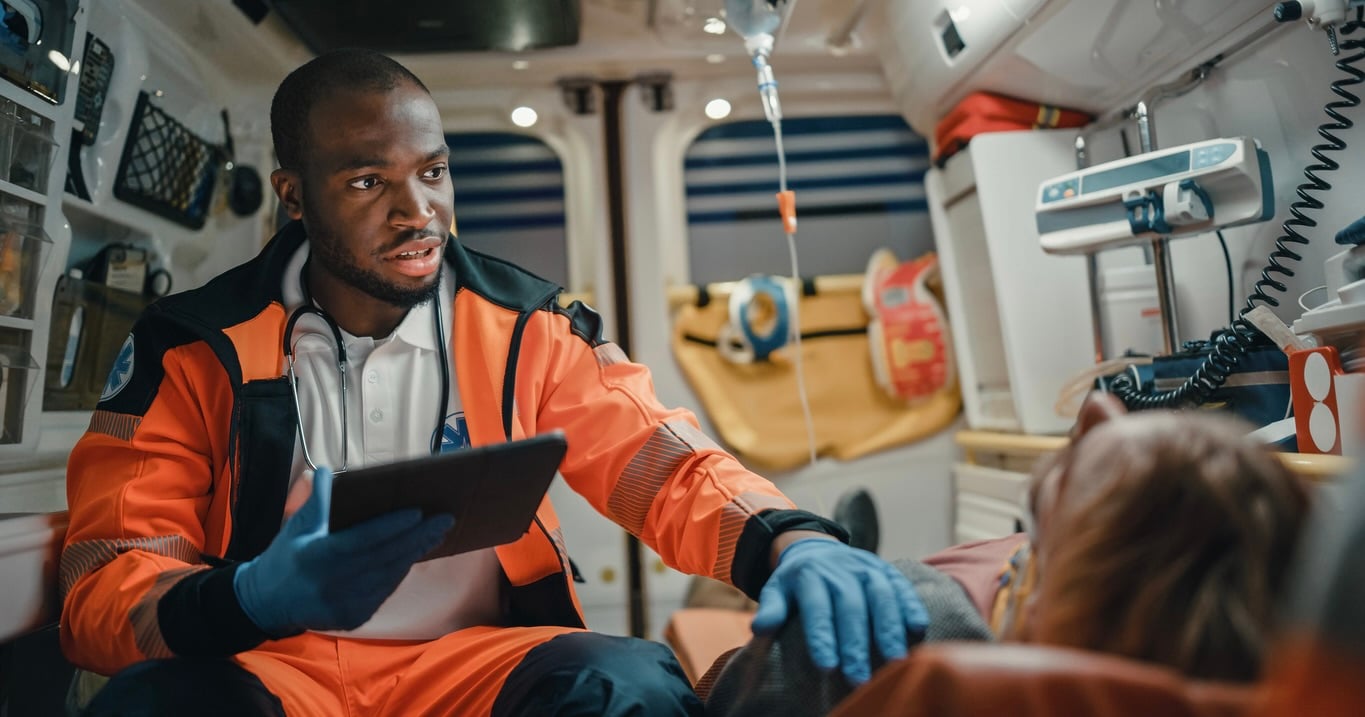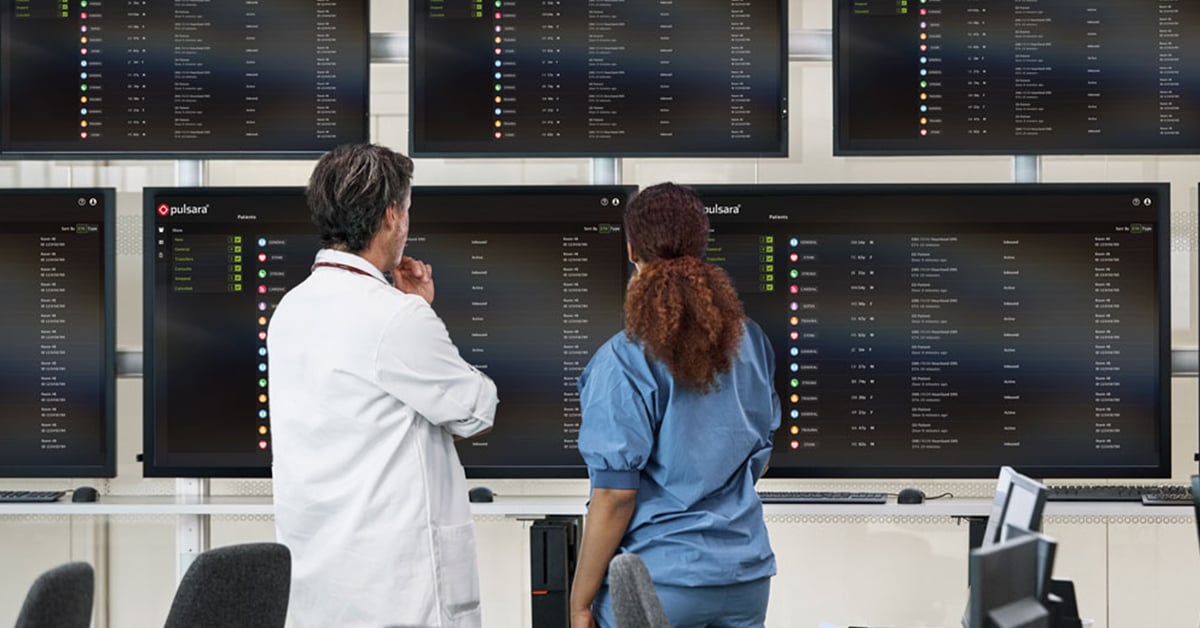Introducing Pulsara Intelligence: AI Tools for Streamlined Emergency Care
In fast-paced clinical settings, documentation often competes with communication and patient care. Pulsara’s mission is to give healthcare workers an...
7 min read
 Kinsie Clarkson
:
Jul 02, 2024
Kinsie Clarkson
:
Jul 02, 2024

Imagine: In the midst of a pandemic, you're managing patient load across a state that covers over 261,000 square miles and is home to over 30 million people. Some of your hospitals have beds, but not enough nurses; some hospitals have enough nurses but are running out of beds. You need to disperse patients to hospitals with resources across the state, and fast.
How do you do it?
Now, imagine you're trying to find a way to track patients during a mass casualty incident and enable better communication between first responders and the hospital.
Is it possible to do using the same tool you used to load balance during the pandemic?
That's exactly what the state of Texas has accomplished. Between load-balancing patients during the COVID-19 pandemic and reimagining MCI response, they've been leveraging a statewide patient wristband system, paired with Pulsara, to help track patients and consolidate communication in a crisis.

Eric Epley is the executive director and CEO at the Southwest Texas Regional Advisory Council (STRAC) which is part of the San Antonio-based Texas state trauma response system. He is also the chair of the Governor's EMS and Trauma Advisory Council's Disaster Committee. In the webinar Streamlining Crisis Response (watch the full webinar below), Epley shared how Texas is simplifying communication and collaboration around patient load-balancing and patient triage, tracking, and reunification during MCIs and large-scale events.
“I believe that day-to-day, well-functioning regional trauma and emergency health care systems are essential to good disaster response," said Epley, explaining his core philosophy for emergency management. But when it comes to emergency response, the size of Texas makes coordination difficult. The population of Texas is just over 30 million people, and the state covers over 261,000 square miles. “In some ways, it's harder to get everybody on the same sheet of music, because things are so different in different parts of the state," said Epley. "That's been a big challenge for us.”
In order to best manage crises on a regional level, Texas is divided into 22 regional advisory councils. The Southwest Texas Regional Advisory Council (STRAC) oversees about 26,000 square miles and 3 million people. The area includes San Antonio, which is the seventh-largest city in the U.S. The area has 71 EMS agencies and 63 hospitals. Of those, they also have 18 air medical bases, 2 level-one trauma centers, 16 PCI centers, and 17 stroke centers, three of which are comprehensive. They also have a significant crisis behavioral health effort.

During the COVID-19 pandemic, providers in Texas experienced breakdowns in their normal communication patterns. Face masks made it difficult to speak clearly over the radio, and for those trying to hear those reports it was equally difficult to understand what was being said.
“When COVID hit, everybody was giving EMS reports that sounded—we used to have…half-face respirators. And so it sounded like this,” said Epley, demonstrating how masks muffled the report. “The nurses were complaining about the patch reports. And, we thought, ‘Hey, you know, Pulsara seemed like a pretty good idea. I think it would be essential now.’ So we transitioned over to that and started using it on regular day-to-day EMS stuff.”
Pulsara enables everyone connected to a patient's care to communicate on a unified patient channel, offering real-time transparency and streamlined collaboration to the entire team. Through the platform, EMS and hospital staff can seamlessly communicate event-based patient information (typed or voice-recorded), including one-tap team notifications, image sharing, audio/video calls, ETA, or even ECG images from the field. The hospital care teams receiving these communications from EMS can also view or play back the messages as many times as needed. This functionality proved to be an invaluable solution to the muffled/patchy radio communication challenges that the Texas care teams were facing.
As the pandemic progressed, they also faced challenges with load-balancing resources across the state. Some regions had beds but not enough staff to care for patients, while other regions were running out of beds. El Paso had a shortage of beds, which meant they needed a way to transfer patients to other areas around the state. There was just one problem: El Paso is over a 7-hour drive from the other major cities in Texas, effectively isolating it. Dubbed "Moon Base, El Paso" by Epley, every movement required a jet and an air medical provider. And on top of that, they needed to move 250 patients in under a month.
“We’d call into the Border RAC and say, ‘Hey, we need to move a patient.’ They would call our State Coordination Office, the coordination center. We would look at the other Regional Advisory Councils and say, ‘Hey, can anybody take this patient?’ All this was all [done through] phone calls, and [it] literally would be, you know, 35, 40, 50 calls just to get one patient accepted.”

They sought out a way to improve their communication infrastructure, and found it in Pulsara.
“There's a transfer feature in Pulsara that hospitals can utilize, and it streamlined all of this for us," said Epley. "It made it much, much simpler. And, you know, the hospitals now are entering the patient into Pulsara, and then they would go to their Regional Medical Operations Center (RMOC) and then that would [go through] the same flow, but with Pulsara, it just made it so much easier. All of the transfer paperwork was there. Any pictures or EKGs, anything.”
Using Pulsara, they were able to coordinate transfers and keep everyone on the team in the loop at every stage of the process, providing a level of transparency they’d never experienced before. For the first time ever, they had visibility into every stage of the process, including when the patient was being picked up. “We had several receiving hospitals say, ‘This is the first time ever we've known like, “Hey, the jet just landed, they’re on the way over to pick up the patient. They're leaving to go back to the airport. Okay. They're lifting off.”’ We've never had this kind of visibility before and it made things so much simpler and easier. This was a big win for us.”
During mass casualty incidents, keeping track of patients is a challenge. To solve the problem, Texas is pairing Pulsara with a new standardized wristband system to track patients and enable continuity of care during MCIs.
Wristbands give each patient a universal ID that follows them throughout their entire care journey, from first medical contact to discharge. When providers encounter a patient, they can give them a wristband and scan it to start a new Pulsara channel for them. Or, if they encounter a patient who already has a wristband, they can use Pulsara to scan the barcode to see any existing information and treatments that have already been provided. No sensitive data is attached to the wristband; everything is contained within the Pulsara app and is accessible only to those directly working with the patient.

Epley likes how the process makes it easy for care providers to join the patient's case and get up to speed quickly. "If [the provider is] in Pulsara, they just walk up, scan that wristband, and they're instantly added to that patient’s communication line. Same thing when they get to the hospital. They show up, they scan the wristband at the hospital, and they're instantly added to that patient. And they can see all the information that's happened since the very first entry. And that's been fantastic. I like to say the wristband and Pulsara is a little bit like, 'Hey, you put chocolate in my peanut butter.' 'No, you put peanut butter in my chocolate.' The two are synergistic and have been super helpful for us."
Pulsara also allows providers to enter information by scanning the barcode on the back of U.S. driver’s licenses. “Pulsara works great to scan that. And then you don't have to enter any demographics, which is pretty cool,” said Epley. Registration can use the information scanned from the driver’s license to preregister the patient before they arrive. “If they actually have a room, they'll put the room number [into Pulsara], and you can walk in looking at your phone and know what room you're going to. And the patient is registered before you even get there, which is slick,” said Epley.
While the functionality has been working well during MCI drills, they are also prepared to use wristbands with Pulsara to track patients during hospital evacuations.
“The evacuating hospitals now have wristbands. ... [Hospitals in Corpus] are going to pre-band and pre-scan and pre-enter all the patients. So when we get there with, you know, 25 trucks and an AMBUS, we're going to clear out a 45-bed hospital. We just walk up and the medics scan it, and they've got everything they need out of the—essentially it's not the medical record, but they grab the paperwork, scan, and now they're in that channel. And when they add the receiving hospital, which we usually do once they're on the way, we coordinate that through our Regional Medical Operations Centers and tell them. Because when they're leaving, they may not know where they're going. Which seems a little odd, but if you have to move 2000 patients in about 36 hours, there are some things that the M.O.T. may not have a destination except ‘RMOC San Antonio.’ And we'll fill that in later as we figure out where those patients are going. We're going to accept it in San Antonio—we just don't know where. ... Evacuations are tough because you're moving hundreds of miles, and so is everybody else. The general population is moving, so it is slower, and we have time to make some of those decisions.”
In order to standardize operations across the state, Texas opted for a statewide wristband that can be used on a daily basis for every patient they encounter. This will build muscle memory that will allow responders to lean on the system during a crisis. In Epley's experience, pulling out a new tool to use during a crisis rarely works as planned. “I’ve always felt like, unless medics are using a technology tool every single day, we should never introduce new technology on game day. It’s not gonna get used,” he said.
“Muscle memory is key. If they do it every day, they’re gonna do it on disaster day.” — Eric Epley
Epley cited triage tags as an example. “I've been a paramedic for over 30 years, and I've flown 15 of those. I've been to a bunch of MCIs in the helicopter. I've never seen a single triage tag used. I mean, really never seen the triage tag used. We talk about them all the time. But it's just not used, because when people get into the worst day of their life as a medic, they're going to do what they know to do. You put a blood pressure cuff on every patient. So ... in a disaster, you put a blood pressure cuff on them. So [by] that theory, ... if you put a wristband on somebody every single day, it just becomes part of what you do.”
Epley feels that making wristbands part of the normal workflow for EMS professionals will also make them a natural part of the process when they respond to an MCI. “Muscle memory is key. If they do it every day, they’re gonna do it on disaster day.”
![]()
In a recent interview with ASPR TRACIE, Eric Epley shared details about Texas's efforts to load-balance patients during the pandemic and how they did it. Check out the full interview here.

In fast-paced clinical settings, documentation often competes with communication and patient care. Pulsara’s mission is to give healthcare workers an...

September Recap The weather may (finally) be cooling off, but our autumn event season is bringing the heat. 12 down in September and another 12 on...

How an Arkansas hospital improved their door-to-needle benchmark success rates across the board and achieved a record treatment time of 18 minutes. ...